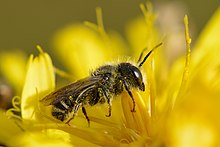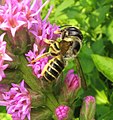
Megachile rotundata, the alfalfa leafcutting bee, is a European bee that has been introduced to various regions around the world. As a solitary bee species, it does not build colonies or store honey, but is a very efficient pollinator of alfalfa, carrots, other vegetables, and some fruits. Because of this, farmers often use M. rotundata as a pollination aid by distributing M. rotundata prepupae around their crops. Each female constructs and provisions her own nest, which is built in old trees or log tunnels. Being a leafcutter bee, these nests are lined with cut leaves. These bees feed on pollen and nectar and display sexual dimorphism. This species has been known to bite and sting, but it poses no overall danger unless it is threatened or harmed, and its sting has been described as half as painful as a honey bee's.

Megachilidae is a cosmopolitan family of mostly solitary bees. Characteristic traits of this family are the restriction of their pollen-carrying structure to the ventral surface of the abdomen, and their typically elongated labrum. Megachilid genera are most commonly known as mason bees and leafcutter bees, reflecting the materials from which they build their nest cells ; a few collect plant or animal hairs and fibers, and are called carder bees, while others use plant resins in nest construction and are correspondingly called resin bees. All species feed on nectar and pollen, but a few are kleptoparasites, feeding on pollen collected by other megachilid bees. Parasitic species do not possess scopae. The motion of Megachilidae in the reproductive structures of flowers is energetic and swimming-like; this agitation releases large amounts of pollen.

The Sapygidae are a family of solitary kleptoparasitic aculeate wasps. They are generally black wasps, similar in appearance to some Tiphiidae or Thynnidae, with white or yellow markings developed to various degrees.

Megachile sculpturalis, known as the giant resin bee and sculptured resin bee, is a species of leafcutting bees belonging to the family Megachilidae.
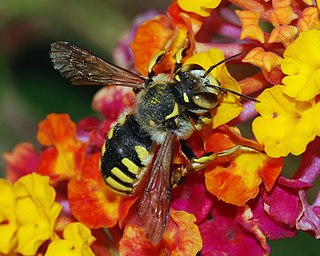
Anthidium florentinum, one of several European wool carder bees, is a territorial species of bee in the family Megachilidae, the leaf-cutter, carder, or mason bees.

Anthidium manicatum, commonly called the European wool carder bee, is a species of bee in the family Megachilidae, the leaf-cutter bees or mason bees.

Megachile campanulae, known as the bellflower resin bee, is a species of bee in the family Megachilidae. Described in 1903, these solitary bees are native to eastern North America. Studies in 2013 placed them among the first insect species to use synthetic materials for making nests. They are considered mason bees, which is a common descriptor of bees in several families, including Megachilidae. Within the genus Megachile, frequently also referred to as leafcutter bees, M. campanulae is a member of the subgenus Chelostomoides, which do not construct nests from cut leaves, but rather from plant resins and other materials. Females lay eggs in nests constructed with individual cell compartments for each egg. Once hatched, the eggs progress through larval stages and subsequently will overwinter as pupae. The bees are susceptible to parasitism from several other bee species, which act as brood parasites. They are medium-sized bees and the female adults are typically larger than the males. They are important pollinators of numerous native plant species throughout their range.
Megachile angelarum is a species of bee in the Megachilidae family.
Megachile abacula is a species of bee in the Megachilidae family.
Megachile zombae is a species of bee in the Megachilidae family. Natively endemic to Malawi and identified in 1977, these are solitary bees. The name derives from Greek mega 'large' + cheil- (χειλ) 'lip' and a district Zomba, in Malawi.

Megachile gentilis is a species of bee in the family Megachilidae. It was described by Cresson in 1872.
Megachile illustris is a species of bee in the family Megachilidae. It was described by T B Mitchell in 1930.

Megachile melanophaea is a species of leaf-cutter bee in the family Megachilidae. It was first described by the British zoologist Frederick Smith in 1853. It is native to North America.

Megachile policaris is a species of bee in the family Megachilidae. It was described by Thomas Say in 1831.

Megachile rubi is a species of leaf cutting bee in the family Megachilidae, found in the eastern United States. First described by Mitchell in 1924, it is placed in the subgenus Xeromegachile, members of which are most often found in sandy areas and have distinct preferences in the petals and leaves they use in their nests.

Megachile texana, the Texas leafcutter bee, is a species of bee in the family Megachilidae. It was first described by the American entomologist Ezra Townsend Cresson in 1878. It is native to the United States and southern Canada.
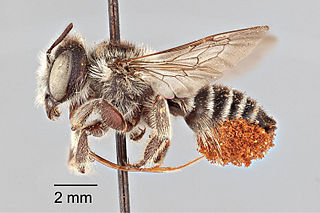
Megachile oenotherae is a species of bee in the family Megachilidae. It was described by Mitchell in 1924.
Megachile umatillensis is a species of bee in the family Megachilidae. It was described by Mitchell in 1927.

Megachile willughbiella, Willughby's leaf-cutter bee is a species of bee in the family Megachilidae. It was described by the English entomologist William Kirby in 1802; he named it in honour of the ornithologist Francis Willughby.
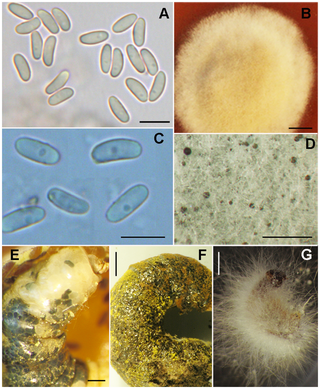
Ascosphaera aggregata is a species of fungus.

